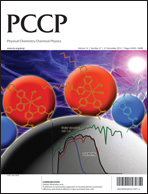Evolution of the structural and electronic properties of beryllium-doped aluminum clusters: comparison with neutral and cationic aluminum clusters†
Abstract
The lowest-energy structures of the AlnBe (n = 1–13) clusters are obtained and compared with the corresponding Aln+1 and Aln+1+ (n = 2–13) as well as AlnMg clusters at the B3LYP/aug-cc-pVDZ level. The configurations of AlnBe show strong resemblances to those of pure Aln+1 clusters, and the first three-dimensional ground state in the AlnBe clusters occurs for Al3Be. Various properties of the AlnBe clusters are systematically investigated using the CCSD(T) method and their thermodynamic properties are also compared with those of corresponding Aln+1+ clusters. The evolution of the energetic and electronic properties with the size of the clusters shows the unique stability of the 20-valence electron systems Al6Be and Al7+, which can be understood from the spherical jellium model (SJM). However, different from Al7+ with 1s21p61d102s2 shell occupation, the electronic-shell structure of 1s21p61d62s21d4 for the Al6Be cluster demonstrates that the impurity atom makes the molecular orbital distribution of doped clusters much more complex than that of pure metal clusters.


 Please wait while we load your content...
Please wait while we load your content...